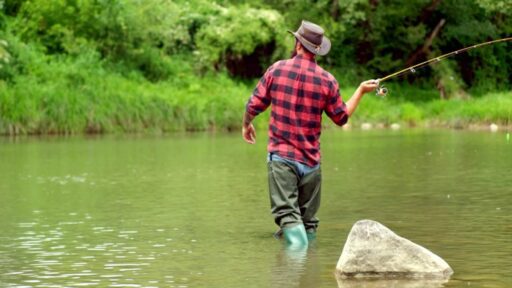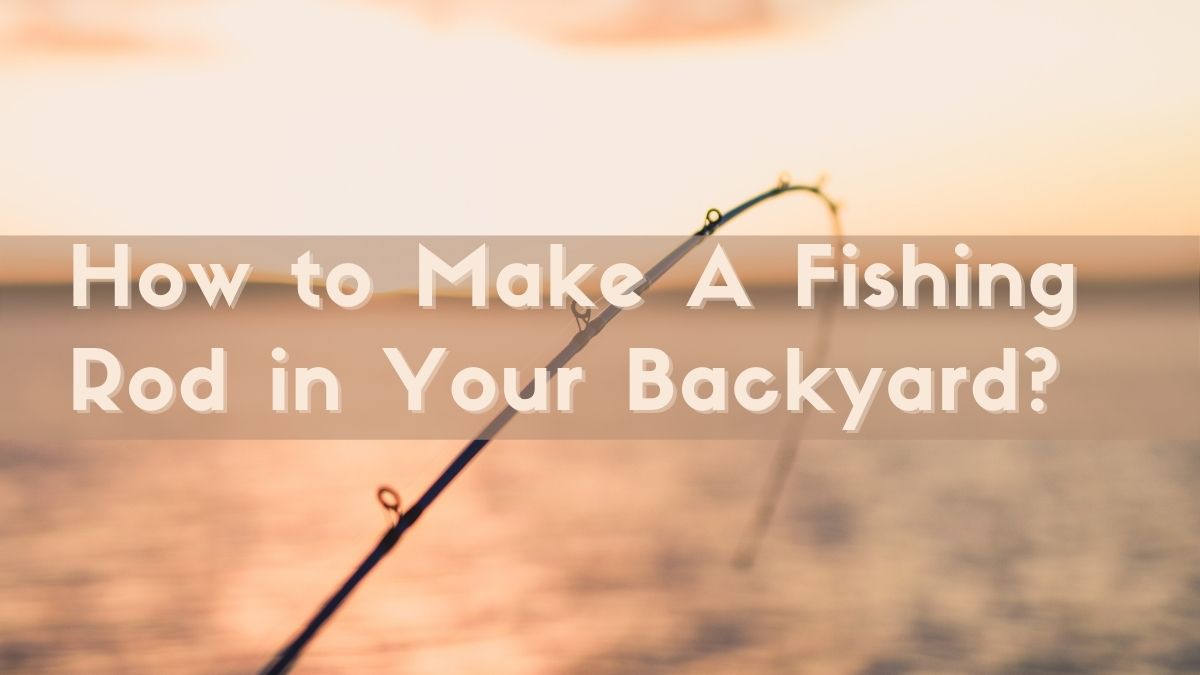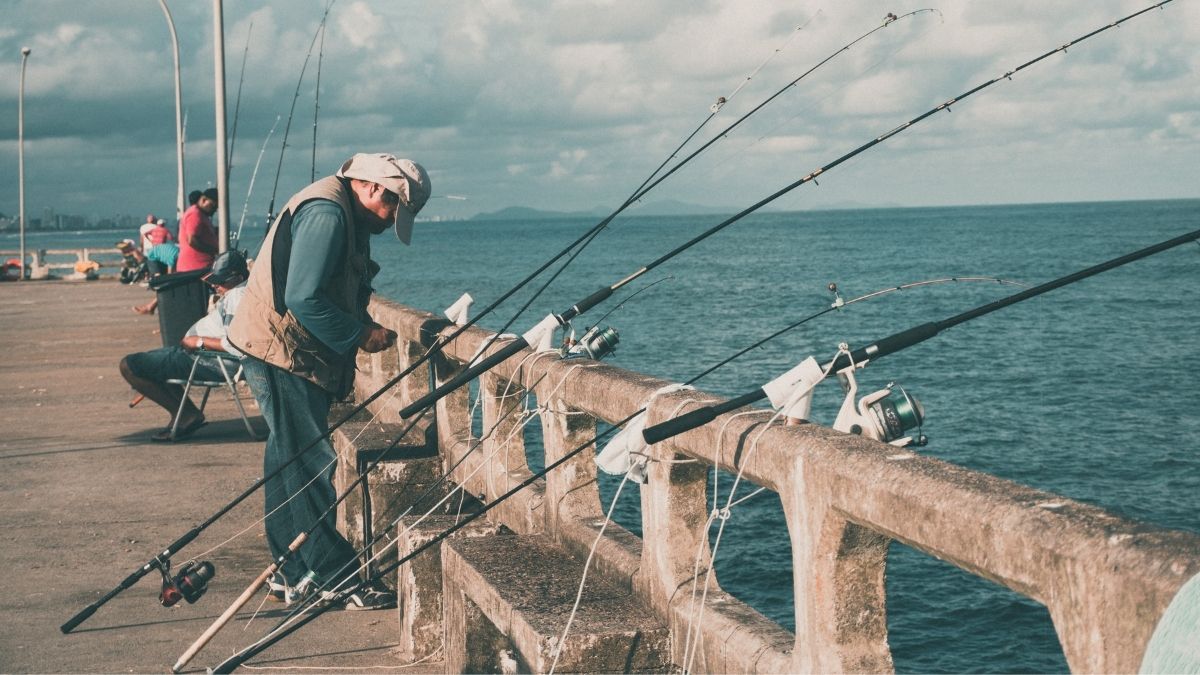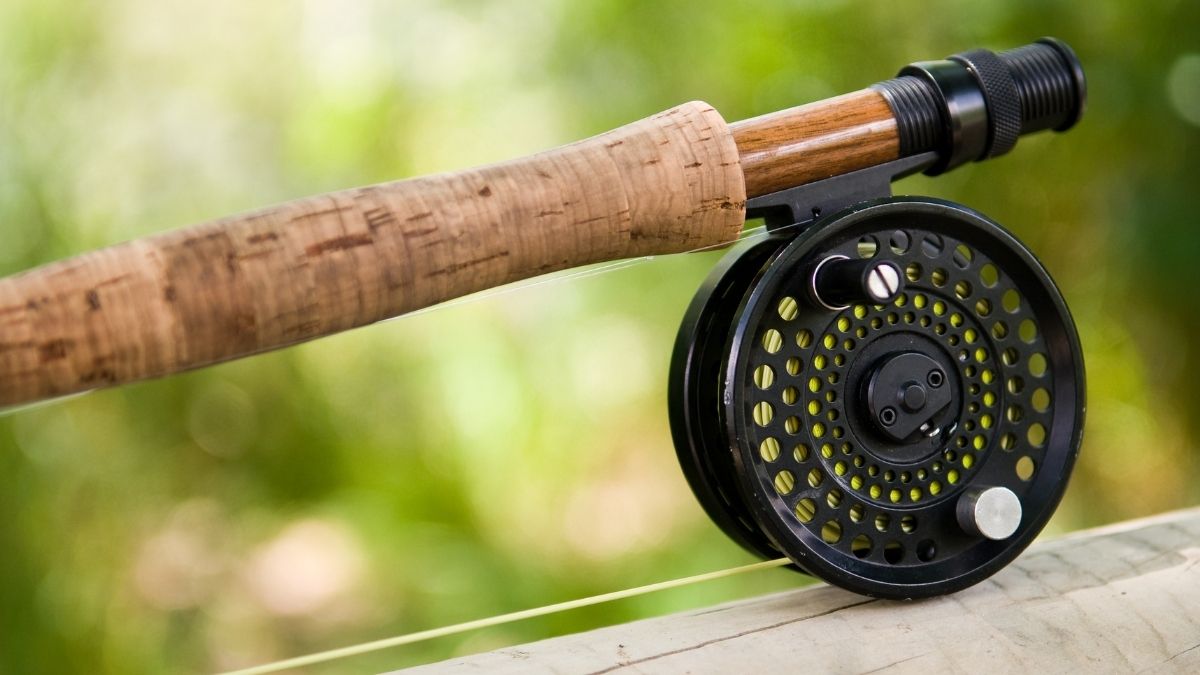Embarking on the quest for the perfect trout fishing rod can be as exhilarating as the sport itself. With numerous specifications, materials, and techniques to consider, this ultimate guide aims to demystify the process, ensuring anglers at any level can make an informed decision. Whether you’re building your own rod, selecting gear for different fishing methods, or practicing conservation-minded fishing, this guide will lead you to the rod that best suits your trout fishing adventures.
Key Takeaways
- Understanding rod specifications such as length, action, and power is crucial for effective casting and trout fishing success.
- The choice of rod material, whether composite, graphite, or bamboo, significantly affects the rod’s performance and feel.
- Different trout fishing techniques, from fly fishing to spey casting, require specialized rods to optimize the experience and catch rates.
- Building your own trout fishing rod allows for customization and a deeper connection with the sport, but requires knowledge of rod building basics.
- Conservation and ethical considerations, including knowledge of local laws and proper catch and release practices, are essential for sustainable trout fishing.
Understanding Trout Fishing Rod Specifications


Rod Length and Its Impact on Casting
The length of your trout fishing rod can significantly influence your casting abilities. Shorter rods offer greater accuracy for precise fly placement, especially in tight spaces or when targeting specific areas. Conversely, longer rods provide increased casting distance and leverage, which can be advantageous in open waters or when needing to cover more ground.
- Short Rods (6-7 feet): Ideal for small streams and precise casting.
- Medium Rods (7-8 feet): Versatile for various trout fishing scenarios.
- Long Rods (8-9 feet and above): Best for large rivers and lakes.
When selecting a rod, it’s crucial to consider the fishing location, your style, and the space available. A rod that’s too long can be cumbersome in tight quarters, while one that’s too short may limit your reach and ability to manage line effectively.
Comfort should also be a priority when choosing rod length. A rod that feels too long or too short can lead to fatigue and affect your overall fishing experience. It’s worth spending time to handle different lengths to find the one that feels right for you.
Action and Power: Choosing the Right Flexibility
When selecting a trout fishing rod, understanding the action and power is crucial for a successful catch. The action of a rod refers to where it flexes when pressure is applied. Fast action rods bend mostly near the tip, medium action rods flex in the middle, and slow action rods bend down into the butt. Each type offers a different casting experience and sensitivity level.
The power of a rod, on the other hand, indicates its strength or the amount of force needed to bend it. This is closely tied to the weight of the fish you’re targeting and the fishing conditions. A light power rod is ideal for smaller trout, while heavier power rods can handle larger fish and tougher conditions.
Choosing the right combination of action and power for your trout fishing rod can greatly enhance your casting accuracy and the overall fishing experience.
Here’s a simple guide to help you match rod action and power with your fishing needs:
- Fast Action: Ideal for long casts and windy conditions.
- Medium Action: Versatile for various fishing techniques.
- Slow Action: Great for beginners and short, precise casts.
Remember, the perfect rod is one that feels right in your hands and suits your fishing style. Don’t be afraid to experiment with different rods to find your ‘wow factor’.
Material Matters: Composite vs. Graphite vs. Bamboo
When selecting a trout fishing rod, the material is a critical factor that affects performance, durability, and sensitivity. Composite rods offer a balance between flexibility and strength, making them versatile for various fishing conditions. Graphite rods are known for their stiffness and sensitivity, allowing anglers to feel even the slightest nibbles. On the other hand, bamboo rods are prized for their classic feel and smooth casting action, though they require more maintenance.
- Composite: Durable, flexible, good for beginners
- Graphite: Lightweight, sensitive, preferred by experienced anglers
- Bamboo: Traditional, smooth action, requires care
Each material brings its unique advantages to the table, and the choice often comes down to personal preference and fishing style. Whether you prioritize durability, sensitivity, or the joy of a traditional fishing experience, there’s a material that’s right for you.
Selecting the Perfect Trout Rod for Different Fishing Techniques


Fly Fishing with Precision: Rods for Dry Flies and Nymphs
When targeting trout with dry flies and nymphs, precision and delicacy are paramount. Choosing the right fly rod is essential for presenting these lightweight offerings in a manner that mimics natural prey. A 5-weight (5wt) fly rod is often considered the versatile workhorse for this style of fishing, balancing the need for finesse with the ability to handle a variety of conditions.
The Marksman, as highlighted by Trident Fly Fishing, is a prime example of a rod that excels in delivering dry flies with precision. Its handsome design and performance cater to anglers who prioritize dry fly fishing and have the budget for a high-quality rod.
For those looking to refine their technique, here’s a list of advanced fly fishing lessons that can enhance your skill set:
- Euro Nymphing
- Small Streams
- Indicators and Dry Droppers
- Prospecting for Trout
- Hatches
Each lesson focuses on a specific aspect of trout fishing, ensuring that anglers can develop a well-rounded approach to fly fishing with precision.
Streamers and Wet Flies: Heavier Rods for Bigger Flies
When targeting trout with streamers and wet flies, anglers often opt for heavier rods that can handle the larger, bulkier flies and the aggressive casting techniques required. These rods typically range from a 6 to an 8 weight, providing the necessary backbone to cast larger flies and manage the fight with potentially larger fish.
- 6 weight: Ideal for medium-sized streamers
- 7 weight: Versatile for various streamer sizes
- 8 weight: Best for the largest streamers and windy conditions
Choosing the right rod weight is crucial for effectively presenting streamers and wet flies to trout. A rod that’s too light will struggle with the aerodynamics of larger flies, while one that’s too heavy may reduce the sensitivity needed to detect subtle takes.
It’s also important to consider the action of the rod. A fast action rod will provide the power for longer casts, but a moderate action may offer better control for precise presentations. The Orvis Clearwater series, often highlighted for its value, is a popular choice among anglers for this style of fishing.
Spey and Switch Rods: Mastering the Art of Two-Handed Casting
Spey and switch rods are specialized tools designed for the angler looking to cover more water and handle larger flies and lines. The two-handed casting technique is essential for effectively using these rods, allowing for graceful, long-distance casts. Spey rods are typically longer, making them ideal for wide rivers and targeting species like steelhead and salmon.
- Switch rods are versatile, shorter than traditional spey rods, and can be used with one or both hands, making them suitable for various fishing conditions.
- Spey rods are longer and are primarily used with a two-handed casting style.
When selecting a spey or switch rod, consider the type of water you’ll be fishing and the size of the flies you plan to use. These factors will influence the length and power of the rod you’ll need.
Here’s a quick look at some popular options and their current pricing:
| Brand | Model | Original Price | Current Price |
|---|---|---|---|
| Far Bank | REDINGTON DUALLY II | $299.99 – $319.99 | $299.99 |
| Rajeff Sports | ECHO SR SWITCH RODS | $329.99 | $329.99 |
Remember, the right rod can make a significant difference in your casting efficiency and overall fishing experience. Take the time to practice your casting technique and get comfortable with the unique rhythm of two-handed casting.
The Role of Gear in Trout Fishing Success


Matching Your Rod with the Right Reel and Line
The synergy between your trout fishing rod, reel, and line is crucial for a successful outing. Selecting the appropriate reel and line for your rod enhances casting accuracy and control. For instance, a lightweight rod pairs best with a reel that balances it well and a line that complements its action.
When considering reels, it’s important to look at the drag system, weight, and balance. Here’s a quick reference list for trout reels by brand:
- ABEL
- LAMSON
- GALVAN
- HATCH
- ROSS
- SAGE
- REDINGTON
- TIBOR
- ECHO
The right combination of rod, reel, and line can make or break your fishing experience. It’s about finding a balance that feels natural in your hands and responds well to your movements.
Lines are equally important and come in various types for different situations. Here’s a simplified breakdown of trout lines:
- GENERAL PURPOSE FLOATING
- INDICATOR LINES
- EURO NYMPH LINES
- LAKE FLY LINES
- SINKING LINES
- DRY FLY & LIGHT TAPER
Remember, the line weight should match the weight rating of your rod to ensure optimal performance. Experimenting with different combinations will help you discover what works best for your fishing style and the trout you’re targeting.
The Importance of Choosing Quality Accessories
When it comes to trout fishing, the devil is in the details. Selecting high-quality accessories can make a significant difference in your fishing experience and success. Accessories such as lures, lines, and leaders must be chosen with care to match the specific conditions and the type of trout you are targeting.
For instance, the right lure is crucial for fly fishing, where the goal is to imitate the trout’s natural prey. A well-chosen lure can be the difference between a successful catch and a day spent watching the water. Consider the following table for a quick guide on selecting lures based on the prey you’re trying to imitate:
| Prey Imitation | Lure Type |
|---|---|
| Mayflies | Dry Flies |
| Caddis | Emergers |
| Stoneflies | Nymphs |
| Midges | Small Nymphs |
Quality accessories go beyond just lures; they encompass everything from the knots you tie to the type of reel you pair with your rod. Ensuring each component is the best you can afford will pay dividends in both the short and long term.
Remember, investing in quality accessories is not just about immediate results; it’s about sustainability and enjoyment of the sport. With the right gear, you can focus on the art of fishing, confident that your equipment won’t let you down.
Fly Rods by Orvis: A Look at a Trusted Brand
Orvis has established itself as a premier brand in the fly fishing industry, with a heritage stretching beyond a century. Their commitment to quality and performance is evident in their range of fly rods, which cater to anglers of all skill levels.
The Orvis Helios series, for instance, represents the pinnacle of the company’s rod-making expertise. The Helios F and D fly rods are lauded for their precision and have been described as Orvis’s most accurate statement ever. With prices starting at $1,098.00, these rods are an investment in top-tier angling performance.
Orvis not only offers a diverse selection of fly rods but also provides a comprehensive fly fishing experience. From endorsed lodges and guides to fly fishing schools and adventures, Orvis ensures that anglers are well-equipped and knowledgeable.
For those looking to delve deeper into the specifics, here’s a quick comparison of the Helios F and D fly rods:
- Helios F Fly Rod: Known for its accuracy, ideal for delicate presentations.
- Helios D Fly Rod: Offers a sturdier build, suitable for casting larger flies and handling tougher conditions.
Building Your Own Trout Fishing Rod


Rod Building Basics for Beginners
Embarking on the journey of building your own trout fishing rod can be both rewarding and daunting. The first step is to gather the necessary components, which include the rod blank, guides, reel seat, handle, and wrapping thread. It’s essential to choose quality parts that match your intended fishing style and the species you’re targeting.
- Rod blank: The foundation of your custom rod.
- Guides: Ensure smooth line movement.
- Reel seat: Secures the reel to the rod.
- Handle: Provides comfort and grip.
- Wrapping thread: Used to attach guides and add a personal touch.
While the process requires patience and precision, the satisfaction of catching trout on a rod you’ve built yourself is unparalleled. Start with a simple design and as you gain experience, you can experiment with more advanced techniques and customization.
Remember, the key to a successful build is not rushing. Take your time to align the guides correctly and secure all components firmly. With practice, rod building can become a cherished part of your trout fishing experience.
Customizing Your Rod: Tips and Tricks
Customizing your trout fishing rod can elevate your fishing experience to new heights. Selecting the right components is crucial for achieving the perfect balance and feel. Start by choosing a blank that suits your fishing style and the type of trout you’re targeting. Then, consider the guides, handle, and reel seat to ensure they complement the blank and your casting technique.
When it comes to the handle, cork is a popular choice for its comfort and grip. However, don’t overlook the importance of the reel seat; it should securely hold your reel and align with the rod’s action. Here’s a simple list to guide you through the customization process:
- Select a rod blank that matches your fishing style
- Choose guides that minimize friction and enhance casting distance
- Opt for a comfortable handle material, like cork or EVA foam
- Ensure the reel seat is sturdy and aligns with the rod’s action
Remember, the goal of customization is to create a rod that feels like an extension of your arm. It should be tailored to your preferences and the specific conditions you fish in.
Finally, don’t hesitate to seek advice from experienced rod builders or utilize online resources. The journey of building and customizing your own rod is as rewarding as landing a trophy trout.
Resources for Aspiring Rod Builders
Embarking on the journey of rod building is an enriching experience that allows anglers to tailor their gear to their specific needs. Finding the right resources is crucial for both beginners and experienced builders. One such resource is Mud Hole, which boasts the world’s largest inventory of rod building components. From MHX to American Tackle, they offer a variety of brands to suit any preference.
For those starting out, it’s important to familiarize yourself with the different components and tools required for rod building. Here’s a list to get you started:
- Rod blanks
- Guides
- Reel seats
- Grips and handles
- Wrapping threads
- Epoxy and finishes
Remember, patience and practice are key to mastering the craft of rod building. Start with simple projects and gradually take on more complex builds as you gain confidence and skill.
Additionally, consider joining online forums and communities where you can share experiences, ask questions, and learn from fellow rod builders. These platforms can be invaluable for gaining insights and tips that can help you avoid common pitfalls and improve your techniques.
Conservation and Ethical Considerations in Trout Fishing


Understanding Stream Access Laws and Fishing Licenses
Navigating the intricacies of stream access laws and fishing licenses is crucial for any angler. Understanding the regulations in your area is the first step to ensuring a legal and enjoyable fishing experience. Different states and regions have varying rules about where you can fish and what kind of access is permitted. Some areas may allow fishing only in specific public waters, while others require permission to fish on private land.
Before heading out, it’s essential to obtain the appropriate fishing license. Licenses are typically categorized by the type of water you plan to fish in—freshwater, saltwater, or a combination of both. In some places, like Florida, residents can opt for a combo license that covers all waterways. Here’s a quick rundown of the types of licenses you might encounter:
- Annual License: Valid for one year from the date of purchase.
- Short-term License: Options for those visiting or planning a short fishing trip.
- Lifetime License: Available in some states for residents, offering long-term savings.
- Combo License: For residents in certain areas, allowing fishing in various types of waters.
Remember, the cost and requirements for each license type can vary, so it’s important to check with your local wildlife agency or fishing authority.
Lastly, be aware that some regions may require you to pass a basic fishing quiz or even an advanced one, depending on the complexity of the local fishing regulations. Staying informed and compliant with these laws not only protects you from fines but also helps in the conservation of fish populations and their habitats.
The Role of Conservation in Trout Habitats
Conservation efforts in trout habitats are crucial for maintaining the delicate ecosystems that support these fish. Healthy trout populations are indicative of a thriving aquatic environment, and anglers play a significant role in conservation by adhering to sustainable practices.
By supporting habitat conservation projects, anglers can help ensure that future generations will have pristine places to fish. This includes being mindful of the surrounding environment, avoiding overfishing, and participating in citizen science initiatives.
Understanding the complex relationships within a trout ecosystem can be aided by studying the aquatic invertebrates that serve as a food source for trout. These organisms are also important indicators of water quality and river health. Here’s a list of steps anglers can take to contribute to conservation:
- Participate in local river clean-up events.
- Report any decline in indicator species to authorities.
- Support organizations that protect wild trout habitats.
- Educate oneself on the diverse trout populations and their specific needs.
Practicing Catch and Release with the Right Equipment
Practicing catch and release is a cornerstone of conservation in trout fishing, ensuring that fish populations remain healthy for future generations. To successfully catch and release trout, anglers must use the right equipment that minimizes harm to the fish.
Proper handling is crucial when practicing catch and release. Wet your hands before touching the fish to protect its slime coat, which is vital for its health.
Here is a list of essential catch and release tools:
- Barbless hooks to reduce injury during hook removal
- Rubberized nets to prevent damage to the fish’s skin and scales
- Hemostats or forceps for safe hook removal
- A quick-measure device to swiftly record the fish’s length
Remember, the goal is to return the trout to the water as quickly as possible, with as little stress as possible. Familiarize yourself with the best practices for handling trout, and always be prepared with the appropriate gear.
Conclusion
In the vast and varied world of trout fishing, selecting the right rod can be the difference between a good day on the water and a great one. Throughout this guide, we’ve explored the nuances of gear selection, from the intricacies of fly lines and reels to the art of choosing the perfect fly rod for trout. We’ve delved into the importance of understanding different fish species, the role of conservation, and the joy of building your own rod. Whether you’re drifting through still waters or wading into the rush of a stream, the knowledge you’ve gained here will help you make informed decisions and enhance your fishing experience. Remember, the ultimate trout fishing rod is one that feels like an extension of your own intuition and passion for the sport. Tight lines and happy casting!
Frequently Asked Questions
What are the key factors to consider when choosing a trout fishing rod?
The key factors include rod length, action and power, material (composite, graphite, or bamboo), and the specific fishing technique you plan to use, such as fly fishing or using streamers.
How does rod length affect trout fishing?
Rod length can impact casting distance and accuracy. Shorter rods offer more control for precision casting in tight spaces, while longer rods can cast farther and handle longer line for different fishing conditions.
What is the difference between rod action and power?
Rod action refers to where the rod flexes when pressure is applied; fast action rods flex mostly near the tip, while slow action rods flex down into the butt of the rod. Power indicates the rod’s resistance to bending under load, affecting the size of fish it can handle.
Why is the choice of rod material important?
Rod material affects the rod’s weight, flexibility, sensitivity, and overall feel. Graphite is lightweight and sensitive, bamboo offers a classic feel with a slower action, and composite rods balance performance and durability.
Can I build my own trout fishing rod?
Yes, you can build your own trout fishing rod. It’s a rewarding process that allows for customization to your preferences, and there are resources available for beginners to learn rod building basics.
What are some conservation and ethical considerations in trout fishing?
Conservation considerations include understanding and complying with stream access laws and fishing licenses, supporting trout habitat conservation efforts, and practicing catch and release with the appropriate equipment to ensure fish survival.





